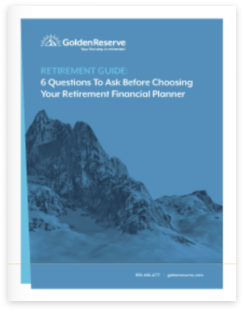Debunking the Retirement Myth: You Don’t Need 2 Million Dollars
Feeling that nagging doubt about your retirement savings? You’re not alone. A recent study found just 49%…
Golden Reserve

We don’t have to explain why the yogurt in the back of your fridge expired. And we’re all pretty clear on why you shouldn’t eat it. But what’s wrong with an expired financial plan? How much damage could it really do?
An expired financial plan won’t give you a case of food poisoning, but its effects may well give you heartburn, because the potential financial consequences of using an expired plan can be stomach churning. So, what makes a plan “expired”? And how can you tell if your plan passes the sniff test?
How Plans Expire at Retirement
No, you didn’t miss a “use by” date stamped on your financial plan, but many people don’t realize that when they’re nearing or in retirement it’s time for a new strategy. The focus is no longer grow, grow, grow, but rather to preserve what you’ve accumulated. Here’s how the expiration happens:
– If You Don’t Have a Tax Plan, You’ll Pay too Much to Uncle Sam
In your earning years, chances are the extent of your tax planning is to sock money away in a pre-tax account. But once you’re in or near retirement, that plan expires. That’s because as your money grows in that pre-tax account, so too does your tax burden, which could take a significant bite out of your nest egg. Suddenly that account balance doesn’t go as far you thought.
The key is timing your required minimum distributions from pre-tax accounts so you can minimize how much you’ll pay Uncle Sam over the course of your retirement. A tax plan will help you determine when to take social security, when to begin taking distributions from your retirement accounts (and how much), and how to minimize what your loved ones will pay on the money you leave them after you’re gone. (For more on this, check out our article on the Widow and Kiddo Penalties.)
– Your Current Portfolio May Be Too Risky for Retirement
You’ve probably heard financial professionals talk about the importance of recalibrating your portfolio as you near retirement to reduce your risk. Yet many people still enter retirement with the same investments as before. That’s problematic considering you no longer have the luxury of time to earn back your losses in the event of a market downturn.
Often, people don’t realize the extent to which their portfolio could fluctuate. A retirement planner will model how your portfolio could go up or down in various market conditions, so you can see whether it aligns with your risk tolerance. Then you can swap investments that are too risky with low- or no-risk options.
– Hidden Fees Can Eat into Your Returns (and Your Retirement)
Fees are everywhere—from what your advisor charges to what you pay for your investments. And you’re not likely to see all those fees clearly outlined on your statement. Over time, these fees can start to eat into your retirement nest egg.
With your current plan, you may be paying your advisor a percentage of what you’ve invested, a compensation model called “assets under management.” This model incentivizes growth—the more you have, the more your advisor makes. However, as mentioned above, the goal in retirement is preservation, not chasing high returns at the risk of your savings.
Similarly, many investments carry high fees that are netted off your returns, making the costs out of sight, out of mind. At Golden Reserve, we have special software that can uncover these fees so you can see the true cost of your investments and replace expensive ones with low- or no-cost, retirement-optimized options. What’s more, we operate on an easy-to-understand flat fee, so the cost of our services is never a mystery.
– The Cost of Long-Term Care Isn’t on Your Radar When You’re Younger
In your 20s, 30s, 40s—heck, even your 50s—the cost of long-term care isn’t on the top of your mind. As such, you’re not likely to prepare for it. But once you’re in retirement, it’s imperative to have a plan. At an average cost over $7,600 per month for a private room in a nursing home, it’s easy to see how long-term care can bankrupt many retirees.
By using an expired financial plan, you miss out on the opportunity to create a strategy to address these costs. Self-funding and expensive long-term care insurance aren’t the only options. There are benefit programs you may qualify for, and legal tools, such as trusts, that could protect your home and assets with enough advanced planning.
How to Un-Expire Your Plan
Consider the Roadmap for Retirement℠ the antacid to your heartburn. It’s a comprehensive strategy tailored to your individual circumstances to help you avoid the stumbling blocks mentioned above. We created the Roadmap for Retirement℠ to equip people in or near retirement with the tools they need to ditch their expired plan and travel safely through retirement. Click here to learn more about the Roadmap for Retirement℠.

Share this article
Feeling that nagging doubt about your retirement savings? You’re not alone. A recent study found just 49%…
“When should you start taking Social Security?” ranks among the top questions researched by retirees. Social Security…
Retirement is a time to relax and enjoy the fruits of your labor. But how do you…
Ever wondered how much your financial advisor is really pocketing from your retirement nest egg? Are you…